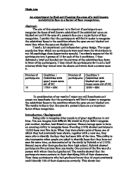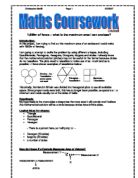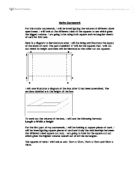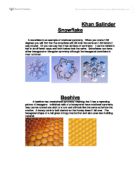In this investigation, we have been told to find out the largest possible volume for an open ended tube made from a piece of paper.
Maths Coursework In this investigation, we have been told to find out the largest possible volume for an open ended tube made from a piece of paper. Squares and Rectangles: I have been given a piece of card measurements 24x32cm: 32cm 24cm I have to find out the largest possible volume for an open ended tube made from this piece of paper. I am considering whether the side used as a base will make a difference to the volume and what affect using different shapes will have. I will start by using squares and rectangles for the base. Firstly, I will use the 24cm side as the base: These are the results I got for the above: 32cm Side y Side x Length of side x Length of side y Area of base (xXy) Volume of tube (areax32) 1 1 352 2 0 20 640 3 9 27 864 4 6 32 024 5 7 35 120 6 6 36 152 From this I can see that in order to get the optimum volume of the tube using a square or rectangular base, using the 24cm side as the base, it is best to use a square base. Next, I shall see if the same applies to using the 32cm side as the base. Here are the results for the above: 24cm Side y Side x Length of side x Length of side y Area of base (xXy) Volume of tube (area x 24) 5 5 360 2 4 28 672 3 3 39 936 4 2 48 152 5 1 55 320 6 0 60 440 7 9 63 512 8 8 64 536 From these results, I can see that it is also better to use a
Beyond Pythagoras - I am investigating the relationships between the lengths of the three sides of right angled triangles, the perimeters and areas of these triangles.
CONTENTS Introduction....................................................2 Proof of Pythagoras' Thereom........................4 Prediction........................................................6 Workings.........................................................7 The Table of Results......................................12 Workings.......................................................13 The Table of Results......................................18 nth term for 'length of shortest side'.............19 nth term for 'length of middle side'...............21 nth term for 'length of longest side'..............23 nth term for 'perimeter'................................25 nth term for 'area'.........................................27 Pattern.........................................................28 The End........................................................29 Investigation: Beyond Pythagors Introduction I am investigating the relationships between the lengths of the three sides of right angled triangles, the perimeters and areas of these triangles. I was set to predict about Pythagorean triples, make generalisations about the lengths of sides and make generalisations about the perimeter and area of corresponding triangles. Pythagorean triples or triad are a set of three positive integers (a, b and c) they are representing the sides of a triangle and satisfying
Transformation Patterns. Our aim was to take different 3 digit number patterns and make a pattern that was instructed in the worksheet, and then find a correlation between the pattern of numbers and the line of symmetry and the order of rotation.
TRANSFORMATION INVESTIGATION BY Naman Shah & Aman More Aim: Our aim was to take different 3 digit number patterns and make a pattern that was instructed in the worksheet, and then find a correlation between the pattern of numbers and the line of symmetry and the order of rotation. For example if the number chosen was X,Y,Z then we were first supposed to take a starting point, and facing up the page go x square forward and turn 90 degrees clockwise. Then we were to go y squares forward and turn 90 degrees clockwise and then go z square forward and turn 90 degrees. We were to repeat these instructions until we got the starting point. Methodology: We used the software MSWLOGO to create the shapes using the number patterns and formulae to repeat the pattern. Our formula basically gave the instructions: repeat (move x units forward, then turn 90 degrees, now move y units forward, then again turn 90 degrees, finally move z units forward and turn 90 degrees) 4 times. This caused the pattern to be repeated until the time it got back to the starting point (the small square). Using observation, we found the number of lines of symmetry (if any) for each shape, along with the order of rotation. We used this process on 28 patterns using different combinations of numbers. Note: There were many instances where there was line of symmetry. Patterns: Data table: Pattern Numbers
Beyond Pythagoras - Pythagorean Triples
Beyond Pythagoras Pythagorean Triples: Three integers a, b, and c that satisfy a2 + b2 = c2 are called Pythagorean Triples. a2 + b2 = c2 The numbers 3, 4 and 5 satisfy the condition because: 32 + 42 = 52 32 = 3 x 3 = 9 42 = 4 x 4 =16 52 = 5 x 5 = 25 32 + 42 = 9 +16 = 25 = 52 . Each of the following sets of numbers satisfy a similar condition of (smallest number)2 + (middle number)2 = (largest number)2 a) 5, 12, 13. 52 + 122 = 132 52 = 5 x 5 = 25 122 = 12 x 12 = 144 132 = 13 x 13 = 169 52 + 122 = 25 +144 = 169 = 132 b) 7, 24, 25 72 + 242 = 252 72 = 7 x 7 = 49 242 = 24 x 24 = 576 252 = 25 x 25 = 625 72 + 242 = 49 +576 = 625 = 252 The numbers 3, 4 and 5 can be the lengths - in appropriate units - of the sides of a right-angled triangle. 3 5 4 The perimeter and area of this triangle are : Perimeter = 3 + 4 + 5 = 12 units Area = 1/2 x 3 x 4 = 6 square units The numbers 5, 12, and 13 can also be the lengths - in appropriate units - of a right-angled triangle : 5 13 12 The perimeter and area of this triangle are : Perimeter = 5 + 12 + 13 = 30 Area = 1/2 x 5 x 12 = 30 (c) This is also true for the numbers 7, 24 and 25: 7 25 24 The perimeter and area for this triangle are : Perimeter = 7 + 24 + 25 = 56 Area = 1/2 x 7 x 24 = 84 Below is a table showing many Pythagorean triples: Length of shortest side (a) Length of
The best shape of guttering
GCSE Math's Gutter Investigation Introduction The purpose of this investigation is to determine the best shape of guttering taking into account a number of different factors, such as the maximum volume and practicality. The gutters I test, shall all be made from a sheet of plastic twenty-four centimetres by four hundred centimetres, as shall my final choice. I shall test both regular and irregular shapes, these shall include triangles, rectangles, polygons and a semi circle. In order to determine the best shape I shall use Microsoft Excel to produce tables and graphs which shall help me to compare the maximum capacity of each Hypothesis I have some expectations as to what my results will be: "The semi-circle shall have the greatest volume and the more sides a shape has the greater it's volume shall be so long as it is regular" The first shape I shall investigate is the triangle as, according to my hypothesis, it should have the least volume. I will start by placing the possible isosceles triangles into a graph, since it is guttering the triangle need have only two sides. This table and graph shows that a triangle with a ninety degrees angle gives the greatest volume I will now test a scalene triangle to see if the area decreases of increases. Net Width Net Length Side Angle Area Volume 24 400 2 70 2.503 5001.2 24 400 2 60 24.625 9850 24 400 2 50
Fencing Problem - Maths Coursework
Fencing Problem - Math's Coursework A farmer has exactly 1000 meters of fencing and wants to fence of a plot of level land. She is not concerned about the shape of the plot but it must have a perimeter of 1000 m. She wishes to fence of a plot of land that contains the maximum area. I am going to investigate which shape is best for this and why. I am going to start by investigating the different rectangles; all that have a perimeter of 1000 meters. Below are 2 rectangles (not drawn to scale) showing how different shapes with the same perimeter can have different areas. Below is a table of different rectangles. Height Length Area 0 490 4900 20 480 9600 30 470 4100 40 460 8400 50 450 22500 60 440 26400 70 430 30100 80 420 33600 90 410 36900 00 400 40000 10 390 42900 20 380 45600 30 370 48100 40 360 50400 50 350 52500 60 340 54400 70 330 56100 80 320 57600 90 310 58900 200 300 60000 210 290 60900 220 280 61600 230 270 62100 240 260 62400 250 250 62500 260 240 62400 270 230 62100 280 220 61600 290 210 60900 300 200 60000 310 90 58900 320 80 57600 330 70 56100 340 60 54400 350 50 52500 360 40 50400 370 30 48100 380 20 45600 390 10 42900 400 00 40000 410 90 36900 420 80 33600 430 70 30100 440 60 26400 450 50 22500 460 40 8400 470 30
Perimeter Investigation
I will be investigating the shape, or shapes, that could be used to fence a plot of land, which contains the maximum area, using exactly 1000 metres. To start I will be investigating the rectangle family as shown below: From these results, the maximum area using exactly 1000 metres of fencing is the rectangle that measures 250 by 250. Its area is 62500m², which is the biggest area and it is square in shape, which proves that the square is the best to use, when investigating four sided shapes. I have plotted a graph from these results obtained: My next investigation will be using triangles to find the maximum area of land that could be fenced, using exactly 1000 metres. I will be using triangles as shown below: Base/m Sides/m Perpendicular Height/m Area/m² 50 475 474.3 1857.5 00 450 447.2 22360 50 425 418.3 31372.5 200 400 387.3 38730 250 375 353.6 44200 300 350 316.2 47430 350 325 273.9 47932.5 400 300 223.6 44720 450 275 158.1 35572.5 From these results, the maximum area using exactly 1000 metres of fencing is the triangle that measures, base 350m, sides 325m and an area of 47932.5m². This triangle is the best to use when investigating 3 sided shapes, because it has the biggest area and a perimeter of 1000 metres. I decided to use regular shapes through-out my investigation because only regular shapes, i.e. shapes with equal
An experiment to find out if seeing the eyes of a well known persons face is a factor of face recognition
An experiment to find out if seeing the eyes of a well known (celebrity's) face is a factor of face recognition. Abstract; The aim of this experiment is to find out if participants can recognise the faces of well known celebrities if the celebrities' eyes are blacked out and if the eyes of a person's face are a major factor of face recognition. I predict that the participants will find it easier to recognise the celebrities' faces in the condition where the eyes are not blacked out more than when the eyes are blacked out. I used a lab experiment and independent group design. The target population from which my participants were used were the 20 students in my AS psychology class (opportunity sample). I randomly separated the 20 participants into 2 groups of 10 for each of the 2 conditions. I then delivered a brief and handed out the pictures of the celebrities face down in front of the participants. I then timed the participants for 2 and a half minutes while they turned over the sheets and wrote their answers upon it. Number of participants Condition 1 Celebrities with eyes ( mean score out of 20) Number of participants Condition 2 Celebrities with blacked out eyes (mean score out of 20) 0 7/20 = 85% 0 3/20 = 65% In consideration of my results I reject my null hypothesis and accept my hypothesis that the participants will find it easier to recognise the
1,000m of fence - what is the maximum area I can enclose?
,000m of fence - what is the maximum area I can enclose? Introduction: In this project, I am trying to find out the maximum area of an enclosure I could make with 1000m of fencing. I am going to attempt to tackle the problem by using different shapes, Including Quadrilaterals, Pentagons, Hexagons, Octogons, Isogons and circles. I already know that the mathematical solution (circles) may not be useful for the farmer because circles do not tessellate. The plots need to tessellate to make use of as much land as is possible - I have shown examples of tessellation below: Historically, farmland in Britain was divided into hexagonal plots to use all available space. Since proper roads were built, this has no longer been possible, as space is at a minimum and roads usually run at the sides of fields. Hypothesis: My hypothesis is the more sides a shape has the more area it will contain and I believe the mathematical solution will be a circle because circles have infinite sides. Logical Ideas for shapes: * Triangle * Quadrilateral * Pentagon * Hexagon - There is a pattern here, so I will jump to: - * Decagon (10 sides) * Isogons (20 sides) * n number of sides How do I know if a Formula Measures Area or Volume? /2 b h measurement x measurement l b w measurement x measurement x measurement Quadrilateral: As with triangles, there are different types of
Acoustics Assignment
Acoustics Assignment Assignment Brief To choose a room and analyse the construction materials and subsequent surface areas of that room, and using the given formula, show an understanding in the calculations involved in solving absorption coefficients, reverb times and standing waves of any given space. Introducing Acoustics Before any formula can be applied, or calculations analysed, a firm understanding must be grasped of the main components involved in this assignment, namely: Standing waves Nodes / Anti-nodes Fundamental frequency Reverberation time Absorption Absorption coefficients Frequency Wallace Sabine Let us consider each heading Standing Waves The modes of vibration associated with resonance in extended objects like strings and air columns have characteristic patterns called standing waves. These standing wave modes arise from the combination of reflection and interference such that the reflected waves interfere constructively with the incident waves. An important part of the condition for this constructive interference is the fact that the waves change phase upon reflection from a fixed end. Because the observed wave pattern is characterised by points, which appear to be standing still, the pattern is often called a 'standing wave pattern.' Nodes / Anti-nodes One characteristic of every standing wave pattern is that there are points along the















